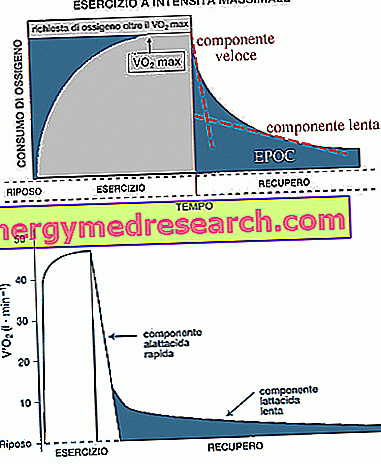At the end of a physical exercise the metabolic activities do not immediately return to their level of rest but they need a more or less long time depending on the intensity of exercise.
This period in which oxygen consumption exceeds the basal values was studied for the first time by Nobel laureate Archibald Vivian Hill, who introduced the concept of oxygen debt for the first time.
This term, now replaced by the abbreviation EPOC (excess post exercise oxygen consuption) indicates, in fact, the difference between the volume of oxygen consumed at the beginning of work and the volume of oxygen consumed in an equal time but in a steady state.
The EPOC is directly proportional to the intensity and duration of the exercise. The more intensity and duration increase and the longer the metabolic level remains at values higher than its basal level.
Hill assumed that this phenomenon was necessary to restore the glycogen stocks affected during exercise and to metabolize the lactic acid accumulated through the Cori cycle.
However, if we look at the evolution of the EPOC shown in the figure, we realize that there are two different phases that together constitute the total recovery time.

These two phases (fast and slow) reflect, respectively, the time necessary to restore the anaerobic alattacid system (creatine phosphate and ATP), and the time necessary to oxidize the lactic acid produced and accumulated during the physical exercise.
This hypothesis, taken up by Margaria in 1964, was confirmed as long ago as 1933 in Boston but the researchers did not have the opportunity to prove it with experimental evidence.
However, at present this hypothesis has also been partially discarded. In fact, many other processes underlying the EPOC have been hypothesized and studied, among which it seems that the main one is the increase in internal temperature that is created in the body following physical exercise.
CAUSES OF EPOC:
- aerobic resynthesis of ATP
- phosphocreatine resynthesis
- re-oxygenation of myoglobin
- glycogen resynthesis from lactate (Cori cycle)
- oxidation of lactate
- effect due to hyperthermia
- effect of hormonal alignment (activation of stress hormones)
- effect of high cardiac, ventilatory and other bodily functions
We then moved from an explanation of the purely biochemical EPOC (ATP, CP and lactic acid) to a biochemical-energy explanation (ATP, CP, lactic acid, ventilation, CF, temperature, hormonal structure, increased energy demand in general).
UTILITY OF EPOC FOR THE ESTIMATE OF RECOVERY TIMES
The study of the extra post-exercise oxygen consumption has allowed us to establish that an active recovery at moderate intensity (50% of VO2max) is more effective than absolute rest. This aspect, valid only if the exercise is of a maximal or submaximal type, seems to find an explanation in the increased perfusion of the muscles and organs that use lactic acid as an energy substrate that occurs during low intensity exercise.
This explains why, between one repetition and another, it is better to recover by continuing the low intensity exercise rather than stopping, lying down or sitting down.



